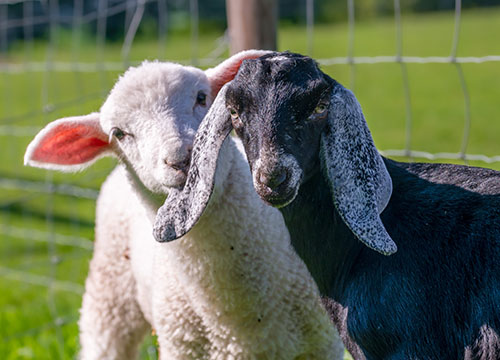Sheep and Goat Inventory
Mar 06, 2023

Written by our friends at the USDA National Agriculture Statistics Service, released on January 31, 2023
The U.S. Department of Agriculture's National Agricultural Statistics Service (NASS) released its Sheep and Goats report showing the Tennessee sheep inventory was unchanged from last year and the goat inventory decreased 6% from last year. Data in the report is based on a survey of farmers conducted in January.
The total number of sheep and lambs in Tennessee on January 1, 2023, was estimated at 49,000 head, unchanged from the previous year's estimate. All breeding sheep and lambs were estimated at 38,000 head and all market sheep and lambs were estimated at 11,000 head. Breeding ewes were estimated at 29,000 head, down 1,000 head from last year, and breeding rams were estimated at 3,000 head, up 500 head from last year. Replacement lambs were estimated at 6,000 head, down 500 head from 2022. Lamb crop for 2022 was estimated at 34,000 head, down 1,000 head from 2021.
All sheep and lambs inventory in the United States on January 1, 2023, totaled 5.02 million head, down 1% from 2022. Breeding sheep inventory was estimated at 3.67 million head on January 1, 2023, down 1% from 2022. Ewes one year old and older were estimated at 2.87 million head, down 1% from last year. Market sheep and lambs on January 1, 2023, totaled 1.36 million head, unchanged from January 1, 2022. Market lambs comprised 94% of the total market inventory. Market sheep comprised the remaining 6% of the total market inventory. The 2022 lamb crop was estimated at 3.11 million head, down 2% from 2021. The 2022 lambing rate was 107 lambs per 100 ewes one year old and older on January 1, 2022, down 1% from 2021.
All meat and other goats in Tennessee were estimated at 85,000 head, down 6,000 head from January 2022. Milk goats were at 7,000 head, down 300 head from the previous year's estimate.
All goats and kids inventory in the United States on January 1, 2023, totaled 2.51 million head, down 2% from 2022. Breeding goat inventory totaled 2.06 million head, down 2% from 2022. Does one year old and older, at 1.52 million head, were down 2% from last year's number. Market goats and kids totaled 451,000 head, down 1% from 2022. Kid crop for 2022 totaled 1.58 million head for all goats, down 1% from 2021. Meat and other goats totaled 2.00 million head on January 1, 2023, down 1% from 2022. Milk goat inventory was estimated at 400,000 head, down 2% from January 1, 2022, while Angora goats totaled 107,000 head, down 3% from last year.
For more content like this, check out the latest issue of The Cooperator.
The U.S. Department of Agriculture's National Agricultural Statistics Service (NASS) released its Sheep and Goats report showing the Tennessee sheep inventory was unchanged from last year and the goat inventory decreased 6% from last year. Data in the report is based on a survey of farmers conducted in January.
The total number of sheep and lambs in Tennessee on January 1, 2023, was estimated at 49,000 head, unchanged from the previous year's estimate. All breeding sheep and lambs were estimated at 38,000 head and all market sheep and lambs were estimated at 11,000 head. Breeding ewes were estimated at 29,000 head, down 1,000 head from last year, and breeding rams were estimated at 3,000 head, up 500 head from last year. Replacement lambs were estimated at 6,000 head, down 500 head from 2022. Lamb crop for 2022 was estimated at 34,000 head, down 1,000 head from 2021.
All sheep and lambs inventory in the United States on January 1, 2023, totaled 5.02 million head, down 1% from 2022. Breeding sheep inventory was estimated at 3.67 million head on January 1, 2023, down 1% from 2022. Ewes one year old and older were estimated at 2.87 million head, down 1% from last year. Market sheep and lambs on January 1, 2023, totaled 1.36 million head, unchanged from January 1, 2022. Market lambs comprised 94% of the total market inventory. Market sheep comprised the remaining 6% of the total market inventory. The 2022 lamb crop was estimated at 3.11 million head, down 2% from 2021. The 2022 lambing rate was 107 lambs per 100 ewes one year old and older on January 1, 2022, down 1% from 2021.
All meat and other goats in Tennessee were estimated at 85,000 head, down 6,000 head from January 2022. Milk goats were at 7,000 head, down 300 head from the previous year's estimate.
All goats and kids inventory in the United States on January 1, 2023, totaled 2.51 million head, down 2% from 2022. Breeding goat inventory totaled 2.06 million head, down 2% from 2022. Does one year old and older, at 1.52 million head, were down 2% from last year's number. Market goats and kids totaled 451,000 head, down 1% from 2022. Kid crop for 2022 totaled 1.58 million head for all goats, down 1% from 2021. Meat and other goats totaled 2.00 million head on January 1, 2023, down 1% from 2022. Milk goat inventory was estimated at 400,000 head, down 2% from January 1, 2022, while Angora goats totaled 107,000 head, down 3% from last year.
For more content like this, check out the latest issue of The Cooperator.